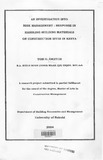| dc.description.abstract | The main aim of this study was to investigate risk management response in the handling
of building materials on construction sites in Kenya.
In the building contract, the contractor's main obligation is to carry out and complete the
works, where as, the employer is to pay the contractor the contract sum. The contract
sum, comprises cost of materials, labour, plant, equipment, contractor's profit and
overheads. It is the contractor's responsibility to ensure the sufficiency of his tender
before entering into the contract. Construction sites arc exposed to various risks such as
workmanship, storage, transit, then, damage etc, that may affect material handling and
consequently, cost of production. In pricing his tender, the contractor is deemed to
incorporate all the risks, which the building contract allocates to him.
Handling of building materials on construction sites is part of the production process,
which commences with delivery of building materials to the construction site up to the
point of fixing them in position. Material handling represents a major portion of total
costs and may account for 10-80% of total cost, (Amrine, 1993). In the computation of
the tender sum, the contractor normally allows a proportion of the material cost for
material handling. This is normally based on the skill and past experience of the
contractor. However, the eventual handling cost depends on the site organization and
management.
It has been observed that then of materials is prevalent on construction sites, (Omondi,
1992) and that is one of the major causes or loss of building materials on site. Waste is
one of the most serious aspects or site production and little is done to avoid this financial
loss, (Edmeads, 1972). Consequently, there is a likelihood that a contractor may meet
losses arising from the handling of building materials.
Responses to these risks may be through contingency funding, insurance cover, risk
reduction and/or retention.
The objectives of this study are to: -
(i) identify the nature of risks involved in the handling of building materials.
(ii) investigate the measures undertaken in risk response by contractors.
(iii) establish the proportion of material loss on construction sites,
(iv) recommend the appropriate measures of risk response.
The target population in the study comprised of construction sites within Nairobi City
Council. A sample, or 47 construction sites were studied. Primary data was collected
through administering of questionnaires to contractors. Secondary data was obtained
from books, journals, research papers and documented reports.
The primary data was analysed using frequencies, descriptive statistics (mean, mode etc)
and the Spearman's rank correlation. The correlation analysis was applied to determine
the relationship between the variables and hypothesis testing.
The types of risk on material handling were identified as storage, transit, workmanship,
theft and damage. It was observed that most construction sites experienced loss of one
material or the other. Risk retention was the most popular response measure considered
at tender stage. It was observed that the final proportion of wastage on materials always
exceeded the proportion allowed at tender stage.
The objectives of the study were fulfilled and risk transfer was recommended as the most
appropriate method of risk response in controlling material losses on construction sites.
The contingency approach and subcontracting as a way of reducing material losses were
suggested as areas of further study. | en |

